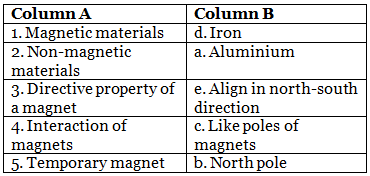Worksheet Solutions: Magnets | Year 8 Physics (Cambridge) - Class 8 PDF Download
Q1: Multiple Choice Questions (MCQs)
(i) What is the unusual property of a magnet?
(a) It attracts all materials
(b) It repels all materials
(c) It attracts only certain metals
(d) It attracts only non-metallic objects
Ans: (c)
Magnets attract specific metals like iron, cobalt, and nickel, not all materials.
(ii) What are the two poles of a magnet called?
(a) East and West
(b) North and South
(c) Up and Down
(d) Left and Right
Ans: (b)
The two poles of a magnet are the north pole (N) and the south pole (S).
(iii) Why does a magnet always point in the north-south direction?
(a) Due to its weight
(b) Because it prefers that direction
(c) Earth's magnetic force
(d) Random alignment of molecules
Ans: (c)
The Earth itself acts like a giant magnet, influencing the direction of freely suspended magnets.
(iv) What happens when like poles of two magnets are brought close?
(a) They attract each other
(b) They move away from each other
(c) Nothing happens
(d) They become stronger magnets
Ans: (b)
Like poles of magnets repel each other.
(v) Why can't the two poles of a permanent magnet be separated by cutting?
(a) Because they are glued together
(b) Each piece becomes a separate magnet
(c) Cutting damages the magnet
(d) It's impossible to cut a magnet
Ans: (b)
Cutting a magnet results in each piece having its north and south pole.
Q2: Fill in the Blanks
(i) A magnet attracts objects made of ________.
Ans: Metals
Magnets attract metallic objects like iron, cobalt, and nickel.
(ii) The end of a magnet that points towards the north is called the ________ pole.
Ans: North-seeking (North) pole
The north pole of a magnet points towards the Earth's north.
(iii) A compass uses the directive property of a magnet to determine _________.
Ans: Directions
The needle in a compass points in the north-south direction, helping determine directions.
(iv) Magnets lose their magnetism if exposed to ________.
Ans: Heat
Heat can demagnetize magnets, causing them to lose their magnetism.
(v) In a horseshoe magnet, the maximum force is found at its ________.
Ans: Poles
The poles of a magnet exert maximum force.
Q3: Match the Column
Match the magnetic materials with their properties.

Ans:
Q4: True/False
(i) A magnet attracts all kinds of metal objects.
Ans: False
A magnet attracts only certain metals like iron, cobalt, and nickel.
(ii) If a bar magnet is hammered with force several times and broken into three pieces, each piece will not be a separate magnet.
Ans: False
Each piece becomes a separate magnet with its own north and south poles.
(iii) The Earth itself is not like a giant magnet.
Ans: False
The Earth itself acts like a giant magnet, with two separate magnetic poles.
(iv) A magnet can attract a magnetic object only in close contact with it.
Ans: False
A magnet can attract a magnetic object from a distance; the magnetic force diminishes with distance.
(v) All magnets mentioned in the chapter are human-made.
Ans: False
Magnets can be natural, like magnetite, or human-made.
|
8 videos|39 docs|11 tests
|















